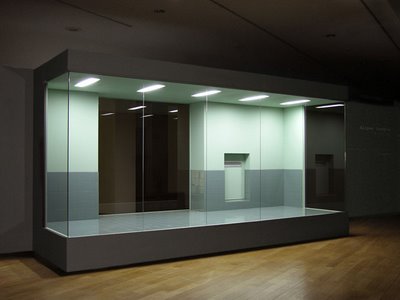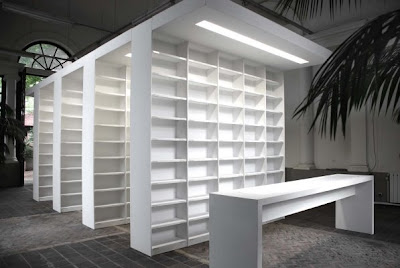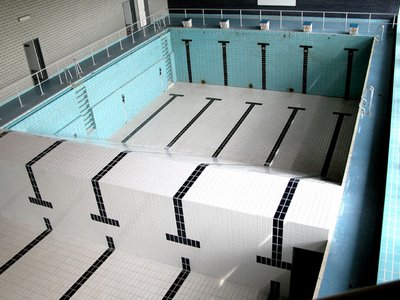Wesley Meuris
Sunday, 7 June 2009
Work from Cages (my title, his works are various cages in the series), Botanical World Archive, and Swimming Pool.
“Since the nineties Wesley Meuris(*Lier,1977) has been fascinated by our relationship with architecture, and more especially by the way we convert particular patterns of thought, needs and desires into functions and codes of behaviour, which we then translate literally into architectural rules and forms. Meuris extracts these forms from their original contexts and reconstructs them, not as a faithful imitation, but as dazzling creations. For example, he distils the form and colour of changing cubicles (Kulak, 2005) and reduces them to a series of parameters, measurements and materials. These give rise to sculptures which he then transposes to ‘another’ context. This leads to powerful, refined and monumental forms often commended for their aesthetic beauty and perfection. (2)
Meuris recently commenced a thoroughgoing analysis and deconstruction of animal cages and aquaria and this led to a new development in his work, called ‘Zoological Classification System’. (3)
Meuris devised two large ‘cage sculptures’ for his ‘Artificially Deconstructed’ exhibition at De Bond, an art exhibition space in Bruges. (4)
The exhibition circuit starts at the back, on the right, at the glass home of a dwarf hippopotamus and then goes to the left, where we see an open cage intended for an okapi. It is striking that Meuris actively involves the entire space and its existing functions, including the toilets and emergency exits, in his sculptures, and vice versa. As a consequence we do not experience art objects standing detached in the space, but rather an ‘all-inclusive installation’ within which the spectator moves with apparent freedom.
As in previous works, the artist is in this case by no means imitating existing animal cages. He bases his cage sculptures on a sort of common denominator from which he designs his own form. He continues his analysis of the architectural form, unlike previous works, which acted as formal and functional statements. Examples of the latter are the Urinal (NICC, 2004), the marvellous Swimming Pool (Eclips, 2004), the mediaeval Trench Latrine 2 x 34L (Ename, 2004) and the 17 1-Person Cabins (swimming pool changing cubicles, Kulak, 2005).
These works are examples of an exploration of isolated objects, whereas the cages can be said to be a systematic analysis of various types and applications. In addition to the incisive study of the architectural aspects, Meuris turns his gaze beyond the physical boundaries and typology of the animal cage. Just as in a zoo or other scientific institution, he hangs extremely credible information panels above the caged animals next to his sculptures. They give the Latin name for the animal, various items of scientific data and a map of the world showing the original habitat.
Where is Meuris taking us? It is in any case doubtful whether all he wants to share with us in the present animal cage series is just the visual splendour or sculptural qualities of these forms. One can interpret this attention to taxonomy and geography in various ways. Some critics opt for a mainly aesthetic analysis and associate this focus mainly with Meuris’ interest in classification, coding, etc. However, in the present article we have opted for another angle.
Whichever way we look at it, the function and origin of an animal cage is far removed from swimming pools, latrines and sports fields, which we can classify as forms of utility or recreational architecture. (5) Historically speaking, the cage lies at the intersection of several customs and cultures that placed great importance on observing, collecting and then exhibiting other people and other things, meaning foreign people and animals. (6)
Human history shows us that there is only a very small gap between seeing, the ‘scientific’ observation of other people, and domination, even appropriation and exhibition. We encounter this desire to dominate in language too. When we communicate with or about someone or something, forms of coding are of course indispensable. In this sense we are obliged to name the other person, and include them in a system of meaning. However, the question is whether we can do this in a non-normative whole and what our actual intentions are. It is perhaps simplistic to say that the wish and above all the ability to name, classify and ultimately to colonise those things or people who are external to ourselves is a matter not only of practical and intellectual interest, but above all of the analyst’s position of or hunger for power, but there is something to be said for it. It should come as no surprise that the first time we come across animal collections and zoos in the course of human history, they are the possession of kings and other powerful people. It was only in the 18th century that the general public was given access to the European menageries of the time. Nor is it at all astonishing that the mainly Western urge for colonial conquest and the birth of the natural sciences made the number of zoos increase exponentially. Of course there is nothing essentially wrong with such things as zoology, the theory of biological classification and taxonomy, or geography, etc. But we can hardly separate the history of these scientific methods and thinking from their anthropocentric and ethnocentric backgrounds. In this series of human discourses the desire for discoveries and scientific research went hand in hand with the occupation and exploitation of regions and all their inhabitants. This in its turn led to the birth of a more extensive cartography and taxonomy and the invention of a set of new buildings and constructions. The zoo and its collection of cages is one of the physical exponents of this. We cannot therefore consider the zoo as separate from other institutions, practices or art forms such as the wunderkammer (collection of curios) and the ethnographic museum, or from the often dubious colonial photography, certain types of travel literature, exotic painting, etc. They are all part of a complex process of interpretation, distortion and ultimately capture of the other, people and animals, which are seen implicitly as inferior.
Fortunately the zoos distanced themselves from this damaging colonial past, but then, despite their scientific aspirations, they opted for a shaky position as part of the ever-expanding leisure industry. Although the present-day zoo often has educational activities and in some cases the conservation of certain endangered species is a policy option, it remains above all an institution where one can satisfy one’s thirst for exoticism, curiosity and sensations. They hold the promise of a reconstruction of the most inaccessible habitats and their occupants, some of whom are dangerous to man. These animals are seized, neutralised and put on show. Both in the cage, and also in the world map and the Latin name, we shut them up in a territory which we ourselves have devised. This process is part of our construction of and relation to reality, but it is at the same time a reflection of an inner mental fact, which is our compelling desire for a strict separation from and the necessary remote control of the other. This may perhaps only have been an incidental intention, but in his combined study of the cage and the taxonomic and geographical description, Meuris touches on one of the cores of our spatial occupation and urge to possess. He rationally deconstructs these architectural forms and their related meaning systems, but at the same time exposes these buildings’ inherent cruelty, but without pedantry, pamphleteering or intending to convey a message.
In his cage sculptures, Meuris puts the emphasis mainly on the perceptibility of the object and the comfort in which we can view it. The animals can be seen from several angles; the sculptures mainly emphasise the position of the spectator. We are forced to consider the question of ‘what, or whom, is Meuris essentially putting on show here?’ Here too one can opt for a purely aesthetic analysis, but can one simply close one’s eyes to so much looking?
In the case of these cages, the viewer’s pleasure comes not only from the experience of the aesthetic brilliance of the sculpture, but is also, almost unnoticed, perfidious.
After all, the spectator can delight in the spectacle of an imprisonment and domination that is perfectly pure because it is cleansed and painless.
The artist accentuates the visibility of a non-image, the absence of the animal, and in precisely this way turns the spotlight on the ubiquitous architectural context, its hidden background and the true protagonist. (7) We saw that an overpowering looking goes hand in hand with forms of literal dominance. The artist is here imprisoning us, shutting us up with our gaze in an animal cage, an emptied stage.
At De Bond, Meuris guides the visitor through a series of changing scales. On the one hand there are the ‘life-sized’ cages, which are themselves miniature versions of the animal’s natural environment, and on the other hand there are the signs with their world maps and the scientific data he makes use of. Finally, he literally absorbs us into the greater overall installation.
This time we wander around in his world. How do we get out of this cage system?
Notes
1. Foucault, Michel; Surveiller et punir, Paris, 1975, p. 234.
2. We here refer, among other things, to Herman Parret’s article in Kunst Nu (October 2005) and various reviews.
3. The first cage sculpture was shown at ARCO in Madrid (February 2005).
4. Meuris’ interest in the deconstructive methods of Jacques Derrida (1930-2004) is apparent not only from the title of this exhibition, but also, and above all, in his artistic practices.
5. Although there can be no doubt that looking at captured animals is for many people a form of leisure.
6. We should not forget that various African peoples were exhibited live, alongside or together with animals. One notorious example is the Khoi-San woman ‘Saartje’, who was displayed all over Europe, often shut up in a cage (see, among other things, Hall, Stuart: The Spectacle of the Other, London, 1997, pp. 264-269). This case turned out not to be unique, and this practice lasted at least until the world exhibition in Brussels in 1958. See, among others, Corbey, Raymond, Wildheid en beschaving, Nijmegen, 1989, including ills. 99, 103, 104, 107 & 108.
7. In this sense, Meuris turns Jeremy Bentham’s renowned panopticon inside out. The guard/spectator is now in the spotlight, and not the prisoner.” – Michel Dewilde


.jpg.jpeg)
